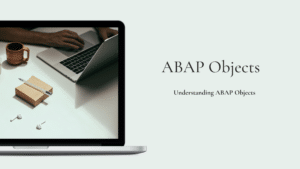At one point, traditional ABAP programming, while reliable, was often incapable of meeting complex management tasks and did not provide the advantages offered by object-oriented programming (OOP). Developers faced issues related to maintaining code modularity, easily integrating into other platforms and performance when their applications expanded over time. This was becoming an ever-increasingly significant concern as applications grew in size and complexity. BAP Objects was introduced with SAP R/3 Release 4.5/4.6 as an OOP extension to ABAP that provides developers with a solid framework to tackle complex business applications.
Table of Contents
ABAP Objects is the object-oriented part of ABAP.
ABAP is expanded by objects. It takes ABAP beyond being a procedural language into object-oriented programming through the addition of an extensive collection of language elements that permit the use of object-oriented programming. This object-oriented extension of ABAP expands its language range and is completely compatible with it. Existing applications can easily use them, and the statement set works to nearly every SAP language range. Certain elements were not compatible with ABAP objects are due to the prior removal of its language scope.

Why ABAP objects?
ABAP Objects was created to address several critical needs in SAP’s programming environment:
- Unified Programming Model: Align internal and external object views within the SAP ecosystem, mainly through the Business Object Repository (BOR).
- Improved Control and Reusability: Objects help manage complexity, encapsulate functionality, and enhance reusability, making the system more maintainable and scalable.
- Integration with External Models: Seamlessly connect with external object models like DCOM and CORBA.
- Foundation for Future Enhancements: Establish a solid base for upcoming features like new GUI programming models and object services.
Core Concepts of ABAP Objects
ABAP Objects integrates many object-oriented principles into the ABAP language, including:
Encapsulation: The majority of classes have visibility sections that are public, secure and private, with regulated access to their parts while protecting internal operations from being seen by external sources..
Classes and Objects: The cornerstone of ABAP Objects. Classes define the blueprint for objects, which are instances of these classes. A class encapsulates attributes (data) and methods (functions), and objects represent specific instances of these classes with their own data set.
Inheritance and Polymorphism: ABAP Objects supports single inheritance, where a subclass can inherit attributes and methods from a superclass, allowing code reuse and specialization.
The key components of an ABAP object are:
- Class: A class is a template or blueprint that specifies the structure and behaviours of objects, as well as their data attributes and methods.
- Attributes: Attributes are data elements that contain information regarding an object’s status or its properties. They are accessible to the public, private or secured based on the level of access they have.
- Methods: Methods refer to the functions or processes that regulate the behaviour for an object. They allow access to and manipulation of the attributes.
- Inheritance: Inheritance enables developers to create classes from existing classes using their attributes, and methods for increasing code reuse, while also creating a hierarchy between objects.
- Polymorphism: Polymorphism allows objects from several classes to be considered as instances of a single superclass that allows flexible binding of methods and method calls.
Encapsulation: Encapsulation is the process of hiding the internal information of an object, while providing a clearly defined interface that can be used to interact with it for the purpose of protecting the integrity of data as well as modularity.
Getting Started with ABAP Objects
To begin using ABAP Objects, you must understand how to define and implement classes, create objects, and use inheritance to build on existing functionality. Here’s a basic overview:
Defining Classes: Use the CLASS and ENDCLASS statements to define a class. Specify attributes and methods within visibility sections (public, protected, and private).
Creating Objects: Declare reference variables using REF TO and create objects with the CREATE OBJECT statement.
Method Implementation: Methods are defined within the class and can be implemented using standard ABAP statements. Constructors are unique methods that initialize objects when they are created.
Inheritance and Method Redefinition: Extend existing classes using the INHERITING FROM clause. Redefine methods in subclasses to provide specialized behavior.
Example: Simple Class and Object Creation
abap
CLASS vessel DEFINITION.
PUBLIC SECTION.
METHODS:
constructor,
drive IMPORTING speed_up TYPE i,
get_id RETURNING VALUE(id) TYPE i.
PROTECTED SECTION.
DATA:
speed TYPE i,
max_speed TYPE i VALUE 100.
PRIVATE SECTION.
DATA id TYPE i.
ENDCLASS.
CLASS vessel IMPLEMENTATION.
METHOD constructor.
id = id + 1.
ENDMETHOD.
METHOD drive.
speed = speed + speed_up.
IF speed > max_speed.
speed = max_speed.
ENDIF.
ENDMETHOD.
METHOD get_id.
id = me->id.
ENDMETHOD.
ENDCLASS.
Conclusion
BAP Objects is a powerful extension that brings modern programming practices to the ABAP language. By leveraging classes, inheritance, and encapsulation, developers can create more modular, reusable, and maintainable code, driving efficiency and effectiveness in SAP environments.This guide should give you a foundational understanding of exploring ABAP Objects and applying these concepts in your SAP projects.
You might also like the below articles.
- clean core sap
- SAP interfaces
- Joule ai copilot
- Mastering sap background job processing
- SAP Ewm tcodes a handy guide
- object oriented programming in sap abap
- understanding sap license costs
- SAP Datasphere
- industry4.0 with sap
- Condition contract management in sap s4 hana
- Comprehensive guide to go live
- SAP EHS Module
- Power of generative ai in sap
- SAP Joule Comprehensive Guide
- Mastering the dunning process sap
- Creation of chart of accounts in sap fico
- Different roles of an sap consultant
- understanding sap system landscape
- Product costing in sap
- Copa in sap
- subcontracting process in sap mm
- SAP S4hana cloud
- Disaster Recovery in SAP HANA Cloud
- SAP ABAP beginner’s journey
- Year-end activities in sap